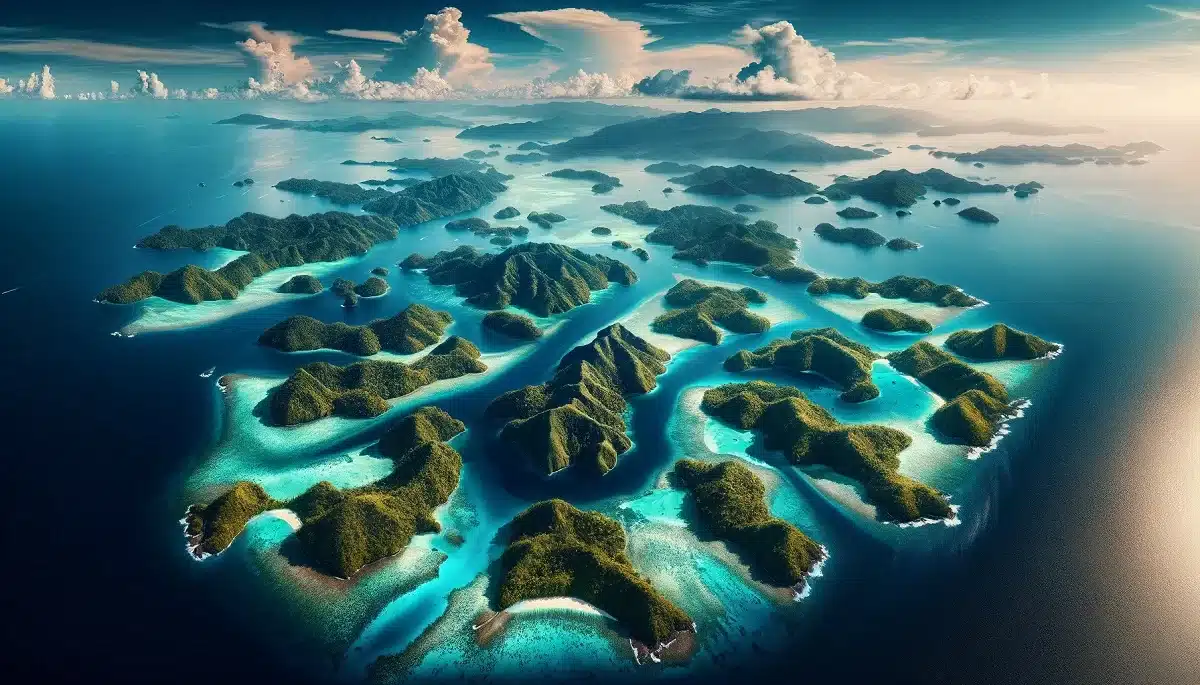The Pacific Ocean is known as the world’s largest and deepest ocean. This vast water body, containing a significant portion of Earth’s water, encompasses numerous seas within its expanse. These seas stand out for their biological diversity, ecological significance, and geographical locations. In this article, we will explore the main seas connected to the Pacific Ocean and highlight their prominent features.
Seas of the Pacific Ocean
The Pacific Ocean is the largest and deepest ocean on our planet. Its arms, extending like vast waterways, offer riches in biological diversity and natural beauty. In this section, we will introduce a few of the significant seas connected to the Pacific Ocean, discussing their geographical positions, climatic features, ecological importance, and natural resources.
Bering Sea
The Bering Sea, positioned between North America’s west and Asia’s east, near the Bering Strait and below the Arctic Circle, is a fertile and productive sea. Its strategic location at the confluence of cold and temperate water currents makes it a biologically rich area. The Bering Sea offers diverse climatic conditions and an extensive ecosystem variety, providing habitat for numerous marine species.
Bering Sea: Unique Ecosystems
The ecosystems within the Bering Sea hold global significance for their biological diversity. Glaciers, open sea zones, and varied depths create complex habitats supporting myriad fish species, mammals, birds, and marine invertebrates. This sea is particularly vital for migratory birds and marine mammals. Besides its biological diversity, the interaction of life forms in the sea and the protection of these ecosystems are crucial for ecological balance.
Sea of Okhotsk
The Sea of Okhotsk, which stretches along the eastern coast of Russia, is located south of the Bering Sea and has a unique geographical location. Cold climatic conditions and rich food resources make this sea an important habitat for large marine mammals, especially whales and seals. In addition to ecological diversity, the Sea of Okhotsk is known for hosting harsh weather conditions and harsh sea conditions.
Sea of Okhotsk: Natural Resources
The Sea of Okhotsk is rich in oil and natural gas deposits and, as such, is of great importance for both the regional and global economy. It is also considered one of the most productive fishing grounds in the world. Commercial fish species in this sea include salmon, cod and anchovy. In addition to its natural resources, sea ice and the unique flora and fauna around it are also a valuable resource for scientific research. Sustainable use of these resources is of great importance for ecological balance and biodiversity.
South China Sea
The South China Sea is a sea of great strategic and economic importance located in the south of East Asia, between China, Vietnam, Malaysia, Brunei, the Philippines and Taiwan. This sea takes over a significant portion of world maritime transport and is a regional strategic transit point. It is also known for hosting various natural resources and important fishing grounds. From the perspective of environmental factors, the protection of the South China Sea is critical for economic activities and the sustainability of marine life in the region.
South China Sea: Ecological Diversity
The biodiversity of the South China Sea is one of the richest in the world’s seas. This diversity includes numerous species of fish, coral reefs, sea turtles, seabirds and other marine creatures. This sea’s ecologically rich habitats, especially coral reefs, have an important role in preserving marine biodiversity around the world. However, factors such as heavy maritime traffic in the region, excessive fishing and marine pollution threaten this rich biodiversity. Therefore, international collaborations and conservation efforts are vital to protect this valuable ecosystem.
Philippine Sea
The Philippine Sea is a large sea located in the western Pacific Ocean, between the Philippines and Taiwan. This sea is known for its deep-sea trenches, active volcanic islands and rich marine life. Deep-sea ecosystems and the geological features found in these ecosystems make the Philippine Sea special from a biological and geological perspective. There are many mysteries in the depths of the sea, waiting to be discovered by scientists.
Philippine Sea: Marine Life
The marine life of the Philippine Sea is particularly notable for its deep-sea fauna diversity. This diversity includes deep-sea fish, invertebrates and other marine creatures. The Philippine Sea is also an important stopping point for many endemic species, as well as migratory marine animals. Preserving this marine biodiversity is of great importance both to maintain ecological balance and to ensure the sustainable use of biological resources.
Tasman Sea
The Tasman Sea is located between Australia and New Zealand and is known for its outstanding natural beauty. This sea offers a rich marine life as it is located at a point where different water temperatures and currents meet. The Tasman Sea’s ecosystems provide favorable habitats for a variety of marine organisms and are a valuable resource for scientific research.
Tasman Sea: Ecology and Research
Ecological research on the Tasman Sea helps us better understand the sea and the life within it. These studies provide information about the behavior of marine creatures, their habitats and their interactions with each other. It is also critical for identifying environmental threats facing the sea and developing strategies to counter these threats. Preserving the natural beauty and biological richness of the Tasman Sea is of great importance to ensure that this unique ecosystem is preserved for future generations.
The Effects and Importance of the Seas Connected to the Pacific Ocean on the World

Since the Pacific Ocean is the largest body of water on Earth, it, together with the seas to which it is connected, creates profound and multifaceted effects on life on our planet. These seas directly affect life and human activities on Earth in many ways, from climate regulation to biodiversity, from economic resources to strategic transit routes. Below, we will examine some main points about the effects and importance of the seas connected to the Pacific Ocean on the world.
Effects on Climate and Weather Conditions
The seas connected to the Pacific Ocean have an important role in the world climate system. Water temperatures and currents in these seas can trigger global climate events such as El Niño and La Niña, which can lead to major impacts on weather conditions around the world. For example, during an El Niño event, the expansion of warm water masses in the Pacific can affect droughts, floods, heat waves, and other weather events on a global scale.
Preservation of Biological Diversity and Ecological Balance
The Pacific Ocean and its connected seas contain most of the biodiversity in the world. Coral reefs, mangrove forests, seagrass meadows and other ecosystems in these seas provide habitat for countless species and play critical roles in preserving biodiversity. Additionally, the fish species, birds and marine mammals that live and migrate in these seas form important links in ecological chains, maintaining the health and balance of ecosystems.
Economic and Strategic Importance
The seas connected to the Pacific Ocean are an important resource contributing to the world economy. Economic activities such as fishing, maritime transportation, and oil and natural gas extraction take place intensively in these seas. At the same time, these seas lie on strategic sea lanes and contain essential chokepoints for global trade. Some seas, such as the South China Sea, contain routes that are vital for the global economy, taking up a large share of the world’s maritime trade.
Global Cooperation and Conservation Efforts
Protecting the seas of the Pacific Ocean requires global cooperation and coordination. The sustainability of ecosystems in these seas can be achieved through international conservation efforts and rational use of marine resources. Additionally, protecting the health of these seas is of great importance in combating climate change, sustaining biodiversity, and preserving marine resources for future generations.
As a result, the effects and importance of the seas connected to the Pacific Ocean on the world are multi-layered with ecological, economic and strategic dimensions. Protecting the health of these seas is one of the keys to a sustainable future for the world.





